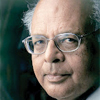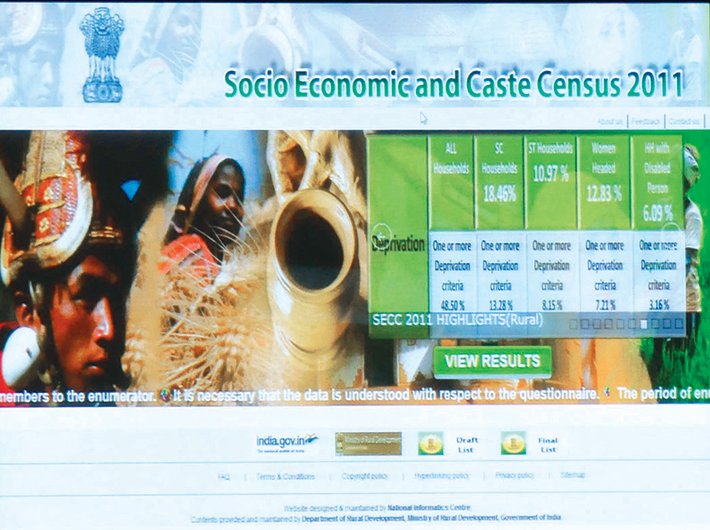For decades, the Registrar of the Census used to be the most unassuming member of the government. His registry counted the population of India once a decade, at midnight on the 31st of March, the end of the financial year. In a few weeks’ time, he gave out the provisional population total. After a few months, he started publishing one massive volume after another, giving statistics of the population – its age, sex, occupation and so on. In a couple of years he would had done his work, and would go underground till the next census.
Socio-Economic Caste Census 2011
So I was quite surprised when I saw billboards of a ceremony in the grand cultural arena designed by Joseph Stein, India Habitat Centre, on 25 March this year: the minister of communications, Ravi Shankar Prasad, made C Chandramouli, the registrar, Web Ratna Open Data Champion Category Platinum. The first winner of the award, given in 2010 by minister A Raja, who went to jail later, was Indian Railways passenger and reservation enquiry system.
I am happy to report that the registrar is free and has returned to obscurity. The figures of the socioeconomic and caste census were released on 3 July. This new census was also organized by the registrar; but it was not a part of the population census. It was held later, between June and December 2011.
The pictures of the release show Arvind Subramanian, the chief economic advisor, flanked by the ministers of finance and of rural development; the registrar is invisible. Not just invisible; Chaudhury Birender Singh, who aspires to develop villages, when asked questions he could not answer, referred interrogators to the director general: he had obviously never heard of the registrar. No paper copy is available of the new census report, and no paper was used to collect the data; they were transferred from handheld electronic counters straight into computers.
So what tempted two big ministers to usurp the place of the registrar? It was the first census publication to give caste figures. But not all of them; only those for backward – sorry, scheduled – castes and tribes. The figures for forward – sorry, other backward, forward, upward and downward – castes were suppressed, no doubt on ministerial command. They have been suppressed since 1941; such secrets must be revealed slowly and wisely, if ever. I refer, of course, to political wisdom.
So what do the figures tell? There were 18 crore families in India; the highest income earner of half of them earned less than '5,000 a month, a fourteenth earned more than '10,000, and a seventh earned in between. That adds up to 71 per cent; what did the remaining 29 per cent earn? Maybe they were budding politicians who did not want to tell their income. What is the connection between families and the income of their heads? Surely what matters is the family income, irrespective of who earns it. Ask the ministers.
Where do the rich live? In Goa, Delhi and Andamans; a quarter of the family heads in those states earn more than '10,000. But only 4 per cent in Andhra. You do not believe it? I do not either. In Nagaland, 4 per cent earn less than '5,000, 1 per cent over '10,000, and 1 per cent in between. Do not ask me about the remaining 94 per cent; the government somehow omitted to find out.
Punjab and Haryana have 48 and 51 per cent of their agricultural land respectively under good enough irrigation for double cropping. Bihar and West Bengal are not far behind, with 40 and 45 per cent respectively. That is the first time I have read that these two states have so much irrigation. For the country, 60 per cent of the cultivated land is irrigated. The figure given by Indian agricultural statistics is roughly 45 per cent. Both cannot be right; and I would rather believe the old, doddering ministry of agriculture than the census registrar. There are many sources and variable degrees of irrigation; asking farmers about them can give unreliable results. I would rather trust standard definitions applied by trained investigators.
Of the families, 48 per cent live in kutcha houses, and 30 per cent in pucca houses. According to the 2011 census, 12 per cent lived in kutcha houses, 62 per cent in pucca houses, and 25 per cent in semi-pucca houses. These figures are obviously inconsistent; and both sets of figures were collected by the census machinery.
My interpretation is as follows. Chandramouli, an IAS officer, was put in charge of the census. He thought or was asked to organize a new activity, namely a rural census, conducted by a separate set of investigators trained to use hand-held micro-computers, whose results could be fed directly into computers. This experiment was a failure; the new census gave very different results from the standard one. Chandramouli did not bother to compare the two results. He organized a ceremony in which Jaitley and Birender Singh “unveiled” the results. The best they can hope is that no one will look at the results and discover their inconsistencies – a hope that has been dashed by one student to date.
(The article appears in the July 16-31, 2015 issue)

